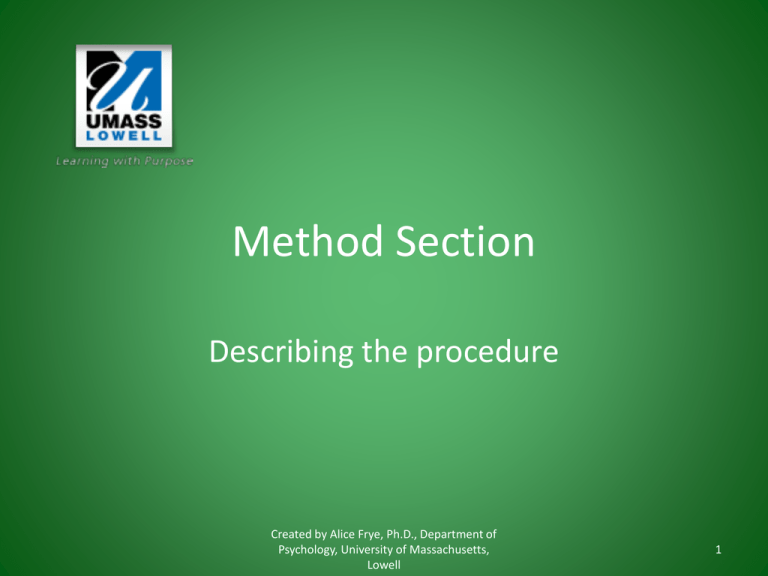Writing a Method Section: Procedure
advertisement

Method Section Describing the procedure Created by Alice Frye, Ph.D., Department of Psychology, University of Massachusetts, Lowell 1 Steps in this tutorial • • • • 1) State the goals of this tutorial 2) What is a method section 3) What is in a method section 4) What is the procedure part of a method section • 5) What goes in the procedure section • 6) The specific elements of a procedure section • 7) Detailed example of a procedure section Created by Alice Frye, Ph.D., Department of Psychology, University of Massachusetts, Lowell 2 Goals of this tutorial • Explain the purpose of a method section • Demonstrate the procedure section of the method section Created by Alice Frye, Ph.D., Department of Psychology, University of Massachusetts, Lowell 3 Objectives • By the end of this tutorial you should be able to – Articulate what the method section of a psychology paper is – State what goes in that section – State the components of a procedure section – Draft a procedure section for your own work Created by Alice Frye, Ph.D., Department of Psychology, University of Massachusetts, Lowell 4 What is a Method Section? • It is the part of the proposal or research paper that describes the methods used to collect the data • It follows the introduction • It allows the reader to understand how the data were collected, and to judge for herself if she thinks the methods were good • It should be detailed enough for a good researcher to be able to replicate the study from reading the method section Created by Alice Frye, Ph.D., Department of Psychology, University of Massachusetts, Lowell 5 What is the Method section? • The method section contains several sections – Participants • Who was in the study – Procedure • What happened in the study – Measures/Materials • What measures were used—like surveys • Or what materials—like special lab equipement – Analysis section-not covered in these tutorials • Describes the statistical analysis Created by Alice Frye, Ph.D., Department of Psychology, University of Massachusetts, Lowell 6 Method Section-Procedure • This tutorial shows demonstrates the procedure section • Other tutorials cover the participants and measures sections Created by Alice Frye, Ph.D., Department of Psychology, University of Massachusetts, Lowell 7 Procedure • • • • • Tells the reader how the data were collected Clearly shows the order in which things occurred States how the sample was recruited Notes who collected the data States clearly all processes or activities participants engaged in • Says what happened in the study • Notes where all the activities took place • May include other important details Created by Alice Frye, Ph.D., Department of Psychology, University of Massachusetts, Lowell 8 How the sample was recruited • The participants section described what type of sample was used – E.g. a convenience sample or simple random sample • The procedures section describes how the sample was actually recruited or contacted Created by Alice Frye, Ph.D., Department of Psychology, University of Massachusetts, Lowell 9 How the sample was recruited • How were they identified? • Where were they recruited? • What method, exactly, was used to recruit them? – For example, with fliers in local grocery stores asking interested volunteers to make contact by phone or email? – Using random digit dialing from a list of phone numbers from an entire zipcode? Created by Alice Frye, Ph.D., Department of Psychology, University of Massachusetts, Lowell 10 How the sample was recruitedexample • Convenience sample: The sample was recruited by posting fliers in five community centers that housed after-school programs for elementary school children. Fliers asked single parents of school aged children interested in a study of learning to contact the researcher if they wanted their children to participate in a brief study of learning styles. Created by Alice Frye, Ph.D., Department of Psychology, University of Massachusetts, Lowell 11 How the sample was recruitedExample-Notes • The exact number of community centers was noted • The fact that the community centers served a specific population was described • Who the flier was targeted at was described – Single parents of school aged children • The wording of the flier was described Created by Alice Frye, Ph.D., Department of Psychology, University of Massachusetts, Lowell 12 How the sample was recruitedExample 2 • For a stratified random sample drawn from a university student population All currently enrolled students were identified and women and men were divided into separate groupings. Women were assigned a number from 1 to 5,390 and men assigned a number from 1 to 6040 (there were 5,390 and 6040 women and men on the rolls respectively). Research assistants drew numbers with a computerized random digit program, and contacted women and men and asked them if they would be willing to join the study, until by sampling with replacement, 400 women and 400 men had agreed to be in the study. Created by Alice Frye, Ph.D., Department of Psychology, University of Massachusetts, Lowell 13 How the sample was recruitedExample 2-Notes • This is for a stratified random sample • The strata—male and female are described • The method of random sampling—using a computerized random digit generator is described • Who contacts them (a research assistant) is noted • How contact is made (by phone) is noted Created by Alice Frye, Ph.D., Department of Psychology, University of Massachusetts, Lowell 14 Who collected the data Things to consider: • Did others collect data, such as teachers, or parents? • Did others collect data, like research assistants? • Did people who collected data have special training or education? • Did they have notable characteristics—that is, was it important that a person who collected the data was male or female or of a certain age, race or ethnicity? Created by Alice Frye, Ph.D., Department of Psychology, University of Massachusetts, Lowell 15 Who collected data-Examples • Here is an example: Licensed clinical social workers conducted all interviews. Social workers and participants were matched by gender, race, and ethnicity, such that Hispanic American men were interviewed by Hispanic American men, African American women were interviewed by African American women, and so on. Trained research assistants collected follow up survey data by phone. Created by Alice Frye, Ph.D., Department of Psychology, University of Massachusetts, Lowell 16 Who collected data-Example-2 • Here is an example: Undergraduate research assistants collected all survey data in pairs of two research assistants each time. Created by Alice Frye, Ph.D., Department of Psychology, University of Massachusetts, Lowell 17 Who collected data-Notes on the examples • Note that in example one, two types of people collected data—social workers and research assistants. • Note that in example one, the gender, race, and ethnicity characteristics of the social workers is mentioned, but not the research assistants. – Note also that this is not mentioned at all in example two. – This is because in one case the researcher believes it is important, and in the other cases the researcher did not believe it was important. Created by Alice Frye, Ph.D., Department of Psychology, University of Massachusetts, Lowell 18 Where did activities take place • Was data collected at a school? • Did interviews happen at home, or at a place of the participants choosing? • Was the place where data was collected private—so that a participant could feel secure in discussing confidential information? • Was data collected in a lab, at a university or other institution? Created by Alice Frye, Ph.D., Department of Psychology, University of Massachusetts, Lowell 19 Where did activities take placeExample • Here are two examples Interviews took place at participants’ homes, or if they preferred, at an alternate location of their choice, such as a coffee shop or public library. Data were collected at schools, daycare centers and afterschool programs in a metropolitan area. Created by Alice Frye, Ph.D., Department of Psychology, University of Massachusetts, Lowell 20 What processes or activities participants engaged in • How was consent obtained? • Were participants interviewed or surveyed? – Individually or in groups? In person or by phone? • Was there a treatment or therapy? • Were materials read aloud, or did participants read to themselves? • Did they take a test or view a film or slides? • Were data collected from participants more than one time? • How long did activities take? Created by Alice Frye, Ph.D., Department of Psychology, University of Massachusetts, Lowell 21 Processes and activities-Example • For a group experiment, this example also includes who and where information. Data were collected from four groups of participants separately, one time for each group. Participants were seated in a college classroom. Prior to the start of the procedure they received the informed consent document, had an opportunity to read it and ask questions, and submitted their signed consent to a research assistant. Participants were first surveyed about their basic demographics, stressful life experiences, and recent anxious symptoms. Then they were shown 4 films each. Experimental condition participants were shown four segments of “scary” films, and control participants were shown four segments of “neutral” films. These activities altogether took approximately 1 hour. Created by Alice Frye, Ph.D., Department of Psychology, University of Massachusetts, Lowell 22 Processes and activities-Example Notes • • • • Shows data were collected in groups Tells where data were collected How the informed consent occurred Describes generally the order in which things happened • Describes that a survey was distributed • Describes that participants were shown films • Notes about how long the process took Created by Alice Frye, Ph.D., Department of Psychology, University of Massachusetts, Lowell 23 Other important details • Were data video or audio recorded? • Did data collection happen at a certain time of day or year? • Did participants receive an incentive? – Money – Course credits Created by Alice Frye, Ph.D., Department of Psychology, University of Massachusetts, Lowell 24 Procedures section-Challenges? • The most challenging task in a procedure section is to get the right level of detail • Enough so that the reader has a clear sense of exactly what happened and how it happened • But not so much that it is boring or overwhelming • Procedures sections in published articles are likely to vary regarding level of detail Created by Alice Frye, Ph.D., Department of Psychology, University of Massachusetts, Lowell 25 Summary • This tutorial explained the purpose and parts of a method section of an empirical paper or proposal • It reviewed in detail the specific components that may be in a procedure section • It demonstrated several examples of procedure sections Created by Alice Frye, Ph.D., Department of Psychology, University of Massachusetts, Lowell 26








